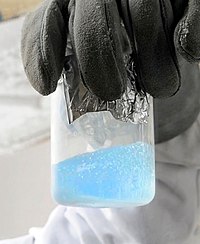
Photo from wikipedia
Electronic transport plays a pivotal role in the electrolysis of semiconducting electrocatalysts for oxygen evolution reaction (OER), while it is mostly underestimated and largely unexplored. Here, by investigating the electronic… Click to show full abstract
Electronic transport plays a pivotal role in the electrolysis of semiconducting electrocatalysts for oxygen evolution reaction (OER), while it is mostly underestimated and largely unexplored. Here, by investigating the electronic transport behavior of seven archetypical crystalline Co/Ni/Fe-based (oxy)hydroxides (unary, binary, and ternary) under OER potential, we study how and the extent to which it affects the apparent catalytic performances. The electronic transports of unary metal (oxy)hydroxides follow the order of Co > Ni > Fe, and their binary or ternary compounds can generally impose one order of magnitude higher electrical conductivity. By studying the dependence of catalytic performances on electrical conductivities, we further unveil that charge transportability not only determines the electronic accessibility of catalytic nanoparticles but also, to our surprise, regulates the reaction kinetics of the electronically accessible active sites. Remarkably, the regulation extent of reaction kinetics correlates with the electrical conductivities of electrocatalysts, suggesting that the electrocatalytic process is strongly coupled with electronic transport. The work presents an overview of electronic transports of crystalline (oxy)hydroxides under OER potentials and highlights their pivotal role in unfolding catalytic potential, holding both fundamental and technical implications for the screen and design of efficient electrocatalysts.
Journal Title: ACS applied materials & interfaces
Year Published: 2023
Link to full text (if available)
Share on Social Media: Sign Up to like & get
recommendations!